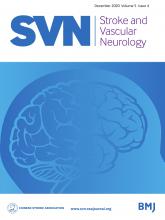Open Access
Multiple hypointense vessels on susceptibility-weighted imaging predict early neurological deterioration in acute ischaemic stroke patients with severe intracranial large artery stenosis or occlusion receiving intravenous thrombolysis
Yong-Lin Liu, Han-Peng Yin, Dong-Hai Qiu, Jian-Feng Qu, Huo-Hua Zhong, Zhi-Hao Lu, Fang Wang, Man-Qiu Liang, Yang-Kun Chen
DOI: 10.1136/svn-2020-000343 Published 29 December 2020
Yong-Lin Liu
1
Department of Neurology, Dongguan People’s Hospital, Dongguan, Guangdong, China
Han-Peng Yin
1
Department of Neurology, Dongguan People’s Hospital, Dongguan, Guangdong, China
Dong-Hai Qiu
1
Department of Neurology, Dongguan People’s Hospital, Dongguan, Guangdong, China
Jian-Feng Qu
1
Department of Neurology, Dongguan People’s Hospital, Dongguan, Guangdong, China
Huo-Hua Zhong
1
Department of Neurology, Dongguan People’s Hospital, Dongguan, Guangdong, China
Zhi-Hao Lu
1
Department of Neurology, Dongguan People’s Hospital, Dongguan, Guangdong, China
Fang Wang
2
Department of Radiology, Dongguan People’s Hospital, Dongguan, Guangdong, China
Man-Qiu Liang
2
Department of Radiology, Dongguan People’s Hospital, Dongguan, Guangdong, China
Yang-Kun Chen
1
Department of Neurology, Dongguan People’s Hospital, Dongguan, Guangdong, China

Submit a Response to This Article
No eLetters have been published for this article.
Multiple hypointense vessels on susceptibility-weighted imaging predict early neurological deterioration in acute ischaemic stroke patients with severe intracranial large artery stenosis or occlusion receiving intravenous thrombolysis
Yong-Lin Liu, Han-Peng Yin, Dong-Hai Qiu, Jian-Feng Qu, Huo-Hua Zhong, Zhi-Hao Lu, Fang Wang, Man-Qiu Liang, Yang-Kun Chen
Stroke and Vascular Neurology Dec 2020, 5 (4) 361-367; DOI: 10.1136/svn-2020-000343

Multiple hypointense vessels on susceptibility-weighted imaging predict early neurological deterioration in acute ischaemic stroke patients with severe intracranial large artery stenosis or occlusion receiving intravenous thrombolysis
Yong-Lin Liu, Han-Peng Yin, Dong-Hai Qiu, Jian-Feng Qu, Huo-Hua Zhong, Zhi-Hao Lu, Fang Wang, Man-Qiu Liang, Yang-Kun Chen
Stroke and Vascular Neurology Dec 2020, 5 (4) 361-367; DOI: 10.1136/svn-2020-000343
Multiple hypointense vessels on susceptibility-weighted imaging predict early neurological deterioration in acute ischaemic stroke patients with severe intracranial large artery stenosis or occlusion receiving intravenous thrombolysis
Yong-Lin Liu, Han-Peng Yin, Dong-Hai Qiu, Jian-Feng Qu, Huo-Hua Zhong, Zhi-Hao Lu, Fang Wang, Man-Qiu Liang, Yang-Kun Chen
Stroke and Vascular Neurology Dec 2020, 5 (4) 361-367; DOI: 10.1136/svn-2020-000343





